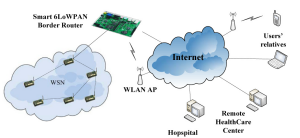Wireless sensor network for e-health
WSN in health care system gives a large quantity of real-time vital signs to be processed and make decision of health states. Since it is not enough for one computer to process the huge raw data from many WSNs, we suggest using Grid computing technology to analyze the vital signals. A SensorGrid gateway to connect the WSN with Grid networks has been designed. Unfortunately, authors do not clearly describe protocol conversion process.
Gateways enable interconnection between WSN and IP network by means of multiple protocols translation in application layer. Such translation in application layer makes gateways have inherent complexity and lack of flexibility and scalability.
We proposed and implemented a prototype of a smart 6LoWPAN border router aimed to locally make decisions of health states using a Hidden Markov Model and enable wireless E-health care sensor network to seamlessly connect with IP network.
The system architecture of E-health care using 6LoWPAN based wireless sensor networks is shown in the following Figure. Medical and environmental sensors are deployed in a user’s home. The smart 6LoWPAN border router as a bridge enables communications between 6LoWPAN WSN and the remote health care center, users’ relatives, and hospitals via IP Internet. On the one hand, it can directly forward the whole payload of packets from sensor node that contains raw medical sensor data or alarm information when collaborative work of multiple nodes is not necessary, e.g., the heartbeat sensor node. On the other hand, the smart border router can collect and record sensor data in the application layer from multiple nodes, makes decisions according to these sensor data and transmits the corresponding health reports and audio or text message warning signal to the remote health care center, users’ relatives, or hospitals. A typical example is that user’s health states can be made decision according to his/her activity which is deduced based on sensor data from multiple nodes. A forward bit located in the first bit of 6LoWPAN packet payload is used to distinguish the two different types.
The border router also enables doctors and users’ relatives can directly access sensor data on each sensor node or get information from the border router.

We executed a series of tests to evaluate the performance of the smart border router. First we tested the system under the situation without emergency events happen. Sensor nodes were turned on and the co-researcher stayed quietly. After one minute, the “remote server” (a PC in university) received the normal report packet periodically from the border router as we expected. Second, we restarted the system to test it with emergent situation. When sensor nodes were turned on, the co-researcher started to do sports. As soon as his heart beat rate was over the normal range, the “remote server” received an emergence data packet. Next, we read the time counting file and checked Ethernet packet delay. The same experiment was repeated 20 times. We also repeated the similar experiments 20 times with the remote server connected through wireless area network.
When remote server was connected with the smart border router through the LAN, it took averagely 0.13 seconds from border router sending an Ethernet package to remote server and receiving the ACK from the remote server. And it took approximately 0.17 seconds when remote server was connected with border router through WLAN. Delay time from GT64 sending a SMS to receiving a reply was 10.84 seconds.


